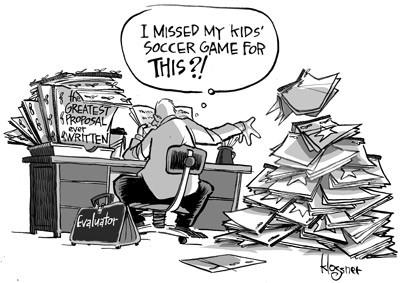Compliant, Complete, and Compelling: How to Write a Winning Proposal
Learning how to write a winning proposal is often an essential part of business operations. A proposal is a detailed, persuasive argument often utilized to secure funding, gather investors, or gain support for a new project. In BRI’s case, it is used to win professional services contracts from both public and private sector clients by responding to formal competitive solicitations, known as a Request for Proposal (RFP).

Proposal comic by John Klossner.
When responding to RFPs, there are typically several firms responding, as well as strict requirements for content, submission, and evaluation. Therefore, it is essential that your proposal stands out from the competition.
Here are three simple strategies to keep in mind with drafting a winning proposal document.
1. COMPLIANCE IS KEYThis tops the list simply because a non-compliant proposal may never even be evaluated. From strict formatting, font size and page limitations to insurance thresholds to how the document is packaged and delivered, it is important to verify that your submittal meets all the specified requirements. One way to accomplish this is to carefully read the RFP and note any unique requirements or procedural steps, and then, at the time of submittal enlist a reliable individual (not responsible for the work) to do an additional check.
Then, once you develop compliant structure and format, you can start thinking about content—the meat and potatoes of the proposal.
2. COMPLETE, THOROUGH RESPONSESThe sections in an RFP usually consist of multi-part questions involving firm structure and background, key staff, specific experience, project references, availability, and reliability. At times these questions may overlap, or even be repetitive, but it is important to respond to each part of each section with complete, thorough responses. Often, procurement may delegate one person to evaluate the same section of each of the proposals submitted. Therefore, even if you have adequately responded to an RFP question in a subsequent section, look for a creative way to reiterate your response.
After ensuring you have thoroughly responded to the questions posed in the RFP it is time to illustrate your expertise.
3. MAKE IT COMPELLINGWhile it is important to restate the client’s needs and establish that you understand the key problems, it is far more important to show exactly how you intend to meet those needs and solve those problems—and why you would do a far better job than anyone else. Use precise nouns and strong verbs to showcase your firm’s specific benefits. For example, use case studies and benefits realized by former clients to highlight past performance and substantiate claims. Where appropriate, use charts, graphics, quotes, and images to keep the reader engaged and reinforce win themes.
Next time you are staring down an 83-page RFP document with no idea where to begin, start with these three simple strategies to make a lasting impact and write a winning proposal.
